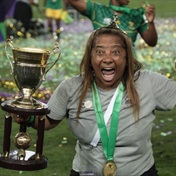
Johannesburg - South Africa’s return to international soccer was showcased at Harare’s Rufaro Stadium in Zimbabwe on August 16 1992.
Still euphoric after a drawn three-match friendly series with Cameroon – who were at the time riding the crest of a wave as the first African side to reach a World Cup quarterfinal (Italy, 1990) – Mzansi was brought down to earth with a mighty thud.
They were walloped 4-1 by a Zimbabwe side featuring the three Ndlovu brothers – Madinda, Adam and Peter – as well as sturdy defender Willard “Mawiii” Mashinkila-Khumalo and Vitalis “Digital” Takawira.
The next game was to be a 1-0 loss to Chipolopolo of Zambia, before another drubbing – this time a 4-0 loss to Nigeria at the Surulere Stadium on October 10 – in the same year.
By the time Bafana Bafana went down 4-0 to Mexico in a friendly on October 6 1993, the team had already attracted a new moniker: the Four by Fours.
That was a great shift from “we will show Africa and the world how we play football Mzansi style” to being the whipping boys.
Single goal
Then the narrative moved to: “We are on a learning curve.” All the coaches, from Stanley “Screamer” Tshabalala and Augusto Palacios to Shakes Mashaba and Clive Barker, sang from the same hymn sheet.
“We are on a learning curve”.
The curve culminated in Bafana winning the 1996 Africa Cup of Nations (Afcon) at home and eventually qualifying for the 1998 World Cup in France.
They were to finish second in the 1998 Afcon, third in 2000, then made the quarterfinals in 2002 – before bombing out in 2004’s first round. Bafana fared worse in Egypt in 2006, when they failed to score a single goal or collect a point.
The decline has been of humongous proportions.
Fast forward to 2015 in Equatorial Guinea and we saw Bafana finish at the bottom of Group C, with a single point and a -3 goal difference below Ghana, Algeria and Senegal.
A cursory look shows that this has been a trend with almost all South African national teams.
Also in 2015, South Africa’s Under-17 team made it to the Fifa Under-17 World Cup in Chile, but the same thing happened. They finished at the bottom of their group with a single point and a -3 goal difference after losing 2-1 to Costa Rica and holding North Korea to a 1-all draw before losing 2-0 to Russia.
A year later, the South African Under-23 and the senior women’s team – Banyana Banyana – did the usual as well: finishing at the tail end of their respective groups at the Rio Olympics in Brazil.
Prognosis
To get to the bottom of this matter and find answers to what went wrong, we need to look back.
Eight of the players in South Korea for the Under-20 Fifa World Cup were in the team that played in Chile two years ago.
A look at the complete first round table shows that they finished in an identical position to 2015’s effort.
So, the simple conclusion is they have not grown in football, only in age.
Why?
The reason is that there was no proper analysis of the Under-17 team’s shortcomings in 2015.
Had that been done, a programme to ensure the players did better in future could have been implemented.
At the tournament in South Korea, one observed the same old problems in South African football.
In the first match against Japan, Amajita failed to protect a first-half lead.
They missed chances that came their way and thus did not seize a victory.
Too much ball possession
When Japan opted for a changed game plan in the second half, Amajita players failed to cope and conceded two goals.
The South African Under-20 players gave away too much ball possession in stray passes.
In the second game against Italy, Amajita played too many long and high balls – something that is not South African football’s forte. As a result, they again gave away too much ball possession.
It was only in the final match against the much stronger Uruguay that Amajita really looked like a wished-for South African football team. They played good possession football and strung precise passes together.
But even in that match, there were two sore points. One was the usual culprit: the failure to convert chances.
The second – one that came as a surprise – was goalkeeper Mondli Mpoto, who decided to pump long high balls forward almost every time he kicked the ball.
Solutions
South Africa needs to strengthen grassroots development in players as young as eight, as suggested by coach Thabo Senong.
What is needed are leagues where very young players are taught the basics, such as the importance of keeping possession; that, as a goalkeeper, you must never be beaten at the near post; and that, as a defender, you must always mark from the correct side – meaning you must always protect your goal.
The South African Football Association (Safa) technical structures must come together to analyse the technical reports.
From those reports, they should formulate a plan to ensure that:
- The same mistakes are not repeated;
- The players are taken to the next level of development to ensure that they perform even better at the next tournament; and
- Serious targets are set for coaches, including that it is unacceptable to bow out in the first round.
Safa has covered some ground in ensuring that junior players participate in tournaments at local, provincial, national and global levels.
The association looks after players when on camp and on national duty, and it must be commended for this, but it needs to be firm in ensuring that it gets a proper return on its investments.
Unless the above takes place, the chances that this Under-20 team will blossom at the next Olympics and the 2022 Fifa World Cup in Qatar will remain slim. They’ll most likely bomb out in the fist round – if they qualify, that is.
Meanwhile, African champions Zambia face Italy in the quarterfinals at 10:00 South African time; and Mexico play England at 13:00.




 Publications
Publications
 Partners
Partners
















